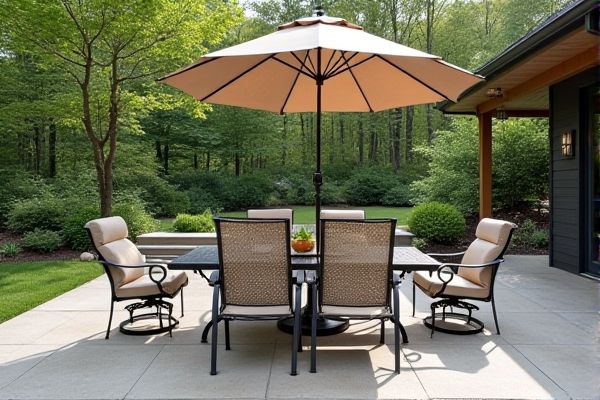
Aluminum patio furniture offers lightweight durability and resistance to rust, making it ideal for outdoor use, while steel furniture provides greater strength and sturdiness but requires more maintenance to prevent corrosion. Explore the pros and cons of each material to determine which option best suits Your outdoor living space in the rest of this article.
Table of Comparison
| Feature | Aluminum Patio Furniture | Steel Patio Furniture |
|---|---|---|
| Weight | Lightweight and easy to move | Heavier and more sturdy |
| Durability | Resistant to rust and corrosion | Strong but prone to rust without coating |
| Maintenance | Low maintenance, easy to clean | Requires regular rust protection and painting |
| Cost | Generally more expensive | More affordable |
| Appearance | Modern, sleek finishes | Classic, robust look |
| Weather Resistance | Excellent for moisture and UV exposure | Can rust and corrode in harsh weather without treatment |
| Lifespan | Long-lasting with minimal wear | Durable but depends on maintenance |
Introduction to Aluminum vs Steel Patio Furniture
Aluminum patio furniture offers lightweight durability and resistance to rust, making it ideal for coastal or humid environments, while steel furniture provides superior strength and a classic, heavier feel that withstands strong winds and daily wear. Your choice depends on balancing ease of mobility and maintenance with the desire for a robust, long-lasting outdoor set. Both materials support various design styles, but aluminum's corrosion resistance typically demands less upkeep compared to steel's requirement for protective coatings to prevent rust.
Durability Comparison: Aluminum and Steel
Aluminum patio furniture offers excellent resistance to rust and corrosion, making it highly durable for outdoor use, especially in humid or coastal environments. Steel patio furniture provides superior strength and heavier weight, enhancing stability, but it requires protective coatings to prevent rust over time. Both materials can last for years with proper maintenance, but aluminum generally demands less upkeep and offers better long-term durability against weather elements.
Weather Resistance and Maintenance Needs
Aluminum patio furniture offers superior weather resistance due to its natural rust-proof properties and ability to withstand moisture and UV exposure without corroding. Steel furniture, while stronger, requires protective coatings like powder coating or regular painting to prevent rust and can demand more frequent maintenance to keep it in good condition. Choosing aluminum reduces your upkeep efforts and ensures your outdoor furniture maintains its appearance despite harsh weather conditions.
Weight and Portability Differences
Aluminum patio furniture is significantly lighter than steel, making it easier to move and rearrange for different outdoor settings. Its low weight enhances portability, ideal for users who frequently store or transport their furniture. Steel furniture, while heavier and less portable, offers greater sturdiness and durability for permanent outdoor installations.
Style and Design Variety
Aluminum patio furniture offers sleek, modern designs with a lightweight frame, making it easy to move and suitable for contemporary outdoor spaces. Steel patio furniture provides robust, classic styles, often featuring intricate detailing and heavier construction for long-lasting durability. Both materials support diverse design options, but aluminum excels in versatility and rust resistance, while steel emphasizes strength and traditional elegance.
Cost Analysis: Aluminum vs Steel Furniture
Aluminum patio furniture generally costs more upfront than steel due to its lightweight and corrosion-resistant properties, which reduce long-term maintenance expenses. Steel furniture is often less expensive initially but may incur higher costs over time for rust prevention, repainting, and repair. Choosing aluminum can offer better value through durability and lower upkeep despite the higher initial investment.
Comfort and Practicality
Aluminum patio furniture is lightweight and resistant to rust, making it easy to move and maintain for your outdoor space. Steel furniture offers superior durability and sturdiness but tends to be heavier and may require regular upkeep to prevent corrosion. Choosing aluminum ensures more comfort with weather-friendly materials, while steel provides a solid, long-lasting option for high-traffic patio areas.
Sustainability and Environmental Impact
Aluminum patio furniture is highly sustainable due to its recyclability, requiring only 5% of the energy used to produce new aluminum when recycled, significantly reducing its environmental footprint. Steel furniture, while durable, has a higher carbon emissions rate during production and is less frequently recycled, resulting in greater long-term environmental impact. Choosing aluminum promotes circular economy practices and lowers greenhouse gas emissions compared to steel alternatives.
Best Use Cases for Each Material
Aluminum patio furniture excels in coastal or humid environments due to its rust-resistant properties and lightweight design, making it ideal for easy rearrangement and outdoor use near water. Steel furniture offers superior strength and durability, best suited for heavy-duty use in colder, drier climates where its weight provides stability against strong winds. Your choice depends on whether you prioritize portability and corrosion resistance with aluminum or robust strength and stability with steel.
Final Recommendations: Choosing the Right Patio Furniture
Aluminum patio furniture offers lightweight durability and resistance to rust, making it ideal for easy mobility and outdoor longevity. Steel furniture provides superior strength and weight stability but requires regular maintenance to prevent corrosion in humid environments. Choose aluminum for low-maintenance, weather-resistant options and steel for heavy-duty, long-lasting pieces in covered or less damp outdoor spaces.
 homyna.com
homyna.com